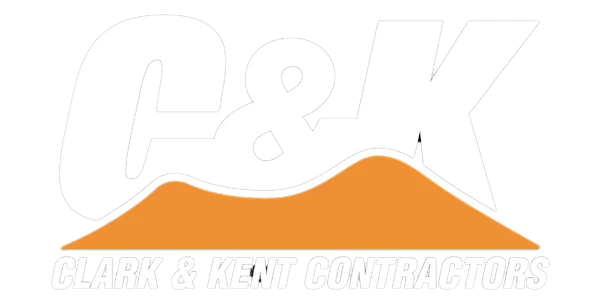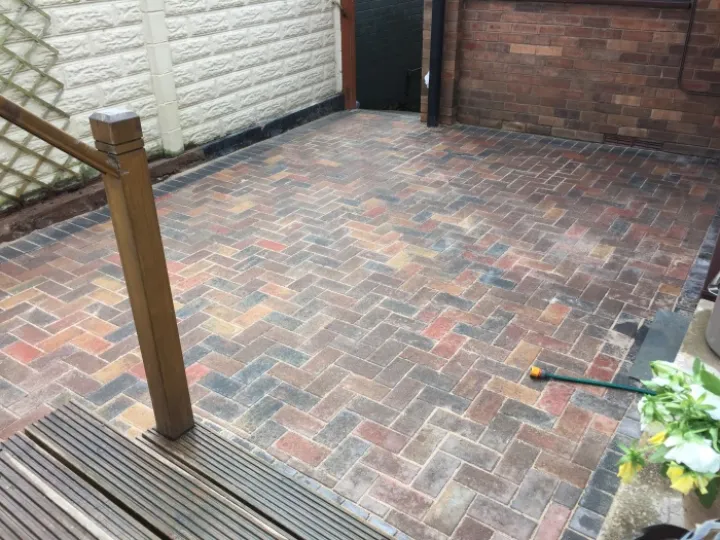Laying Block Paving
Block paving for drives and patios
Block paving has been booming in recent years with householders taking advantage of new developments in mass production manufacture and lower prices.
Block or brick paving also looks good on all types of driveway, patio, yard and path and can give many years of wear if paving blocks are laid correctly.
And because the individual unit blocks or bricks are relatively small paving blocks allow the creation of many unique designs without too much trouble.
Of course, we recommend that your block paving is laid by a professional like Clark & Kent Contractors who have tremendous experience and expertise in this type of work, but there is no reason why you shouldn't have a crack at laying block paving yourself provided you have basic DIY skills.
Design and preparation
The first step in any laying block paving project is to have a clear idea of what it is you want to achieve. And before even drawing up a design you may like to research the products that are currently available.
Block paving comes in two basic types, moulded concrete blocks and kiln-fired bricks. All are on the market in a range of sizes and thicknesses, and your choice should depend on the where and how they are to used.
Driveways, for example, will need to take more weight than backyard patios. In general blocks of 50-60mm thickness are excellent for patios and paths while 80-100mm is better suited to those drives and yards that are destined to be used by vehicles, even thicker if the area is to get some heavy use.
Concrete block pavers
Concrete block pavers come in a cast range of colours and textures but, because of variations in standard sizes and thicknesses, it is probably best when buying to stick to a single manufacturer to ensure consistency of colour and fit when it comes to laying the block paving.
Rectangular concrete blocks come in various sizes, but generally, you can fit 50 blocks to a square metre. Most block pavers have one coloured face for display using a dye that can extend right through the paver or just applied to the surface or 'face' of the block.
Because dyes are used, the colour in concrete block pavers can fade over time, especially with the cheaper types.
Brick block pavers
Brick pavers also come in a wide variety of colours and textures but, unlike concrete blocks, the colour is natural, so they are not as subject to fading. Clay bricks, however, are much harder than concrete and will need diamond tipped tools for cutting.
A common mistake for the amateur is to lay standard house bricks or 'commons' as pavers. This practice is not a good idea as house bricks will crack and disintegrate over time, especially laid in permanently damp conditions.
Paving foundations
Groundworks are vital to ensure that paving is laid correctly and sitting on a suitable sub-base layer. After marking the area out, you may decide to hire a mini digger to carry out the excavation work.
Clark & Kent Contractors have mini diggers for hire at competitive rates, either with a drive or self-drive hire and can deliver anywhere in the UK. Mini digger hire can save a lot of backbreaking work, depending on the size of the excavations.
After marking out, the area needs to be dug down to the required level. This level will depend on the depth of paving you intend to use and the proposed level of the surface. For areas near a building, you must take care that the top layer is at least 150mm below any damp proof course.
It is a good idea to create a slight slope so that the water drains off and the paving doesn't form standing pools in wet weather. A general guide is to allow a fall rate of between 1:40 and 1:80 and take care that you incorporate this slope into the sub-base layer.
Edge restraints may be needed if the paving is not butted against an existing wall. These are usually kerb blocks laid on a 100mm cement foundation and haunched with more cement.
When ready, a sub-base is laid between the edge restraints. It is vital that foundations are firm if the paving is to last more than a few years. Many professionals recommend a MOT Type 1 roadstone raked to a depth of about 50mm.
Vibrating compaction plates should be used to ensure the sub-base is flat and firm. We recommend several passes with the compactor before screeding the site with a 50mm layer of damp sand and compacting again.
Finally, a 20mm 'bedding' layer of sharp sand is carefully raked on top, levelled with a straight edge, checked for the correct slope and compacted yet again before beginning the block or brick laying process.
An alternative method is to lay block paving on a concrete sub-base, but this method is little used in the UK except on large projects
Laying the block paving
The astute will allow 5% wastage when ordering paving for laying patios and driveways. A fully interlocked 'herringbone' pattern is best for areas that get heavy use or are to be driven over by vehicles, but other designs are fine for low traffic areas like paths and patios.
Always start laying the paving from the bottom of the slope, working upwards. It is useful to take the bricks from different packs simultaneously to avoid banding and give the paved area a more random look.
Pavers are best laid using a vertical motion to ensure the spacing lugs lie flush. Avoid placing a block then pushing it into place horizontally. It's a good idea to check every ten layers or so that the paving is aligned correctly and lying neatly on the slope.
Once the main blocks are laid, cut the paving to fit the edges using a block splitter or a cut-off saw. Try and avoid cutting off more than a third of the paver, although this is not always possible.
When all the paving is laid, and you are satisfied with the result, give the area a thorough sweep to clear away any debris then brush dry sand across the whole site, making sure that the sand falls between the joints.
Finally run over the project with a compacting plate, preferably one with a neoprene or rubber faceplate to avoid any scuffing or cracking. Continue sweeping with sand and compacting until all the joints are filled.
A well-laid area of paving will require relatively little maintenance. Sweep regularly to avoid a build-up of debris and treat the surface with weedkiller occasionally. Clay pavers are more liable to attract algae and should be treated once a year with an appropriate cleaner.
Talk to the professionals
Although amateurs can do an excellent job of laying block paving it is usually better to get experienced professional to carry out the work. Mistakes are highly visible, and repairs can be lengthy and expensive.
Clark & Kent Contractors have extensive experience in laying block and brick paving for domestic, commercial and industrial customers, and they have the equipment on hand to ensure a perfect finish that will last many years.
Clark & Kent can act as a one-stop solution for your block paving work providing cost-effective solutions to meet all your requirements, from excavation, preparing a sub-base, screeding and laying and compacting the blocks.
Our skilled workforce and specialist machinery will ensure that your block paving project will be faultless. For a FREE QUOTE on all your paving and landscaping needs CONTACT US now.
Clark & Kent Contractors are the experts in block paving for drives and patios. Call us now on 01630 672329.
Clark&Kent Services Hire
Providing quality specialist plant hire equipment for construction services


